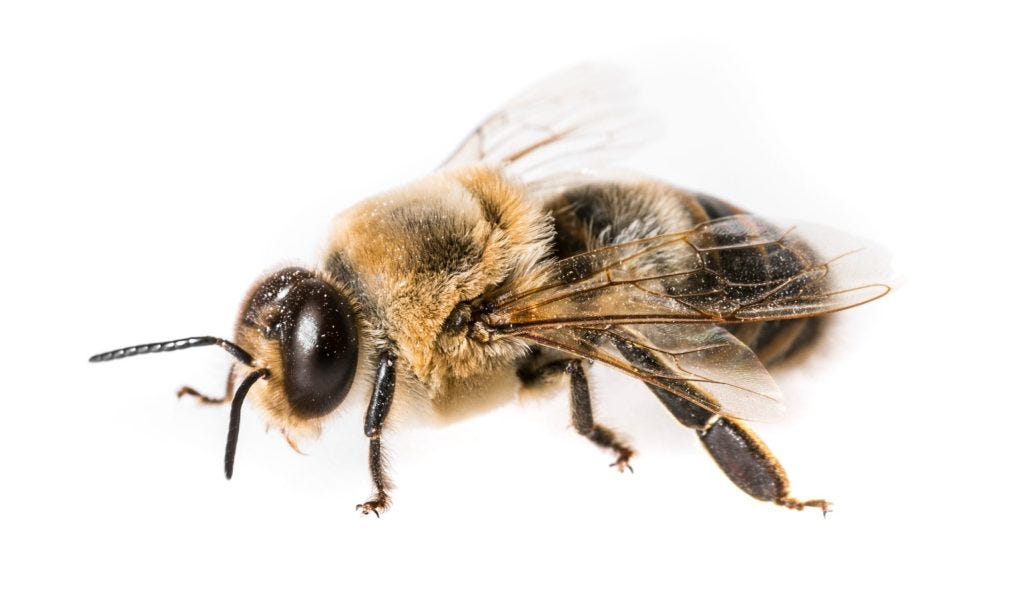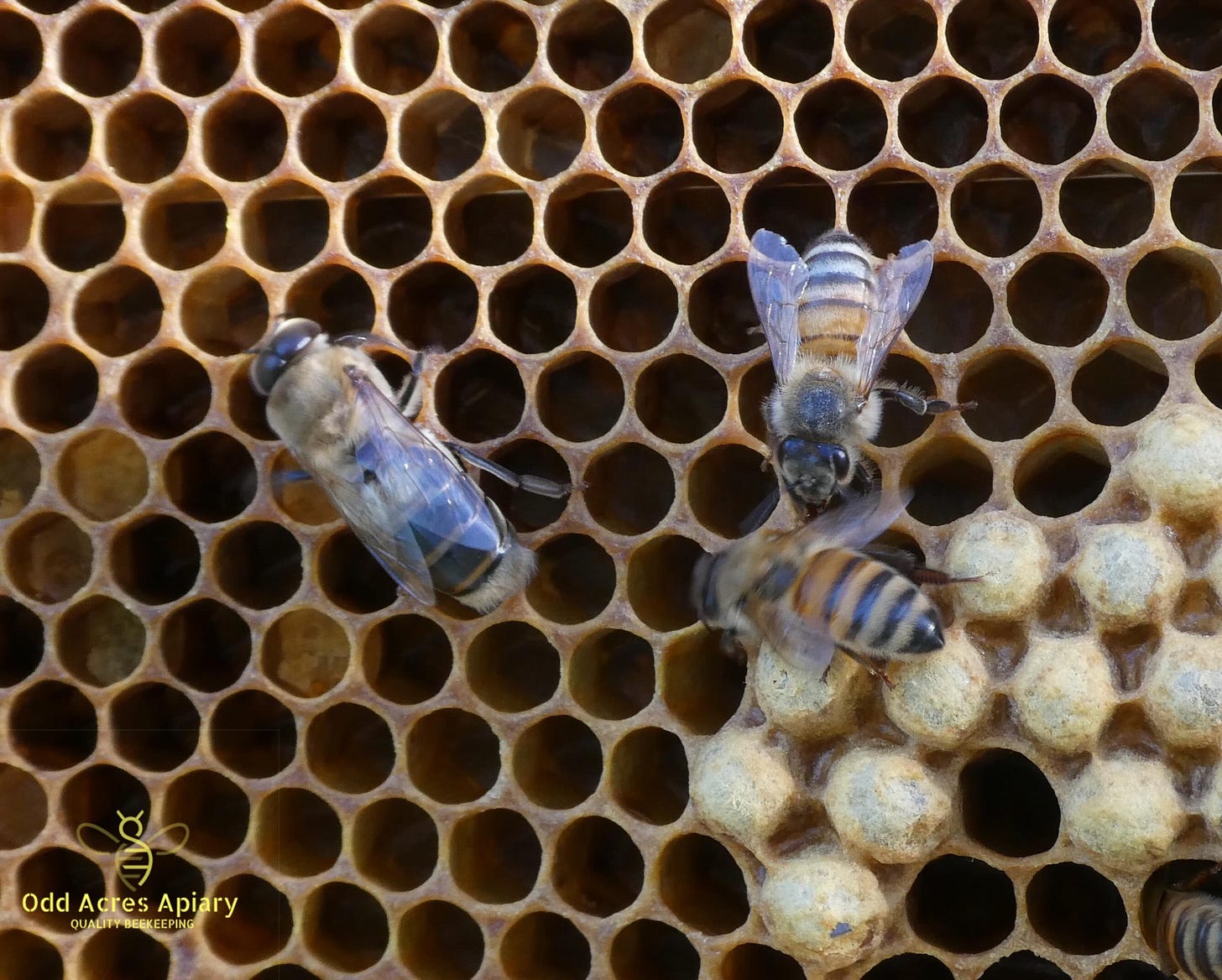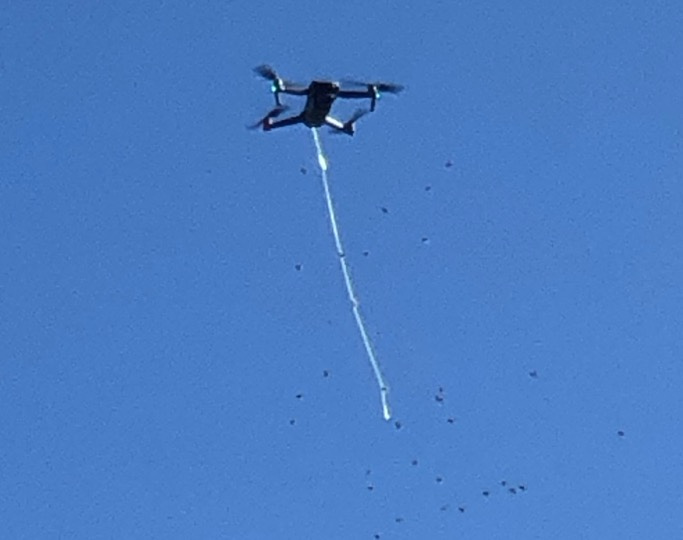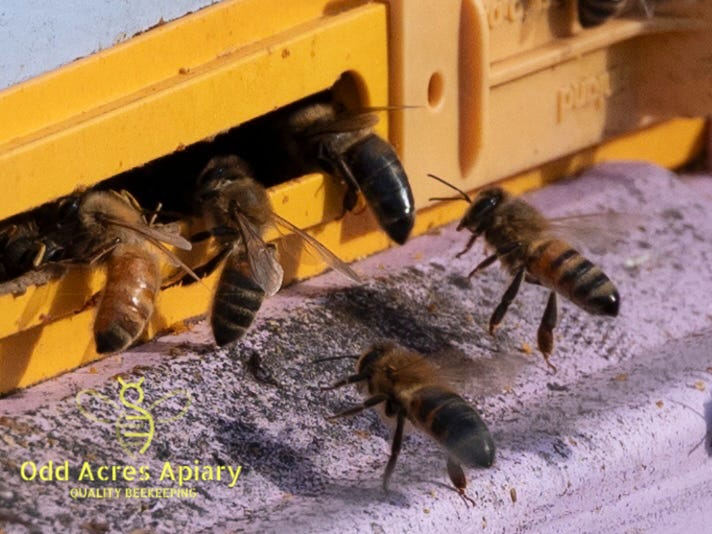Local Adaptation Part 1 - Drones
Live and let live!
This post is the first of a series on local adaptation in honeybees. Beekeepers who don’t move their colonies will depend on local adaptation in their bees so as to get the maximum harvest possible and - in lean years - gain a harvest at all! Survivability is also an important aspect of local adaptation resulting in colonies that do not require feeding and can sustain themselves, even after a poor season. I thought I would start with drones because they are so central to how an eco-system impacts a population of colonies with selection pressure that favours bees that are the best fit for the region in which they live.
Honeybees are often depicted in literature and poetry as symbols of perseverance, productivity, and plenty. Drones, in contrast, are metaphors for sloth and futility. But, as a queen breeder, I value drones as the main purveyors of a colony’s genetic success. My colleagues often scorn them as a drain on resources. Not surprisingly, drone culling is emerging as a popular mechanical preventative as part of organic varroa mite management. I’m not convinced that this practice impacts mite numbers sufficiently to warrant the level of intervention, particularly as brood breaks accompanied by the appropriate organic treatment is much more efficacious and requires similar levels of manual effort. As I will discuss at the close of this article, the flooding of drone congregation areas (DCA) with desirable (i.e. varroa resistant) genetics means that I need every drone that I can get. In fact, I rear colonies with massive drone populations adjacent to these DCA to maximise the chances of my drones mating with not only my virgin queens - but the virgins of the colonies in the areas serviced by the DCA. No drone culling for me…..
Drone Basics
First, some basic facts about drones. Of the three types of bees in a colony, the queen and workers are female, and the drones are male. The figure below compares a drone (on the left) alongside two female workers on the right. The main visual differences are:
drones are larger – nearly 2.5 times the size of the workers;
the eyes of a drone are much larger than their sisters (about 3 times larger);
a drone's thorax is nearly twice as deep as a worker's, housing powerful flight muscles to drive the larger wings that extend to the end of their abdomens in contrast to the smaller wings of the workers;
drones can be quite distinct in their colouring and patterns when compared to their worker counterparts;
drone abdomens are not tapered at the end like worker bees and the queen, but square and butt shaped; and
drones don’t have stingers.
In summary, drones are larger, more powerful in flight, and vastly enhanced in terms of visual and pheromonal sensors compared to the other bees in a colony. As explained below, drones are supreme athletes who compete with each other to gain the prize of mating with a queen on her mating flights.
Other important facts about drones that are not visible in our photograph above include:
the development cycle from an egg to the emergence of a drone is the longest within the hive at 25 days, whereas the workers are 21 days and 16 days for a queen) - ergo the preference of varroa mites for drone brood, namely more chances to reproduce,
drone antennae are larger and more sensitive with 16,000 plate receptors; the worker antennae have 2,600 plate receptors,
drones have smaller tongues and mandibles compared to their sisters and typically only feed in the hive; this is why drones do not forage,
drone eggs are typically laid in early Spring until late Summer. Peak drone production is during swarm season,
in most cases, 10-15% of the brood nest comprises of drone brood,
drones reach sexual maturity around two weeks after they emerge from their cells and usually live for 3-5 weeks, and,
if a drone is lucky to mate with a virgin queen, the act of inseminating the queen will mortally injure the drone.
Drone Congregation Areas
In most cases, a virgin queen requires the services of 15-20 drones or more during her mating flight to ensure that the colony she is to head is well-provisioned with diverse genetics (the basis of what is known in the biz as “polyandry”) as well as an adequate lifetime’s supply of sperm. A colony’s drone population must in turn collectively mate with the virgin queens of as many foreign colonies in their region to spread their genes and maintain their genetic presence in the ecosystem (“panmixia” - another biz term). Our figure below illustrates these concepts.
In this example, the queen of a particular colony at the left of the figure will attempt to mate with as many unrelated drones as possible from the colonies on her right. Her drone prodigy will attempt to mate with as many queens in the ecosystem as they can achieve as well. If by some chance a queen mates with one of her own drone prodigy - as illustrated in the bottom right corner of the diagram - then she will suffer from a small degree of inbreeding. The chances of this occurring are vanishingly small in a diverse, random distribution of colonies in a natural ecosystem but queen bee breeders must pay attention especially to this possibility because the whole nature of queen breeding is diametrically opposed to random distributions. I will cover this in a future post as it is a subject that deserves its own discussion.
To achieve this genetic diversity efficiently, bees gather at Drone Congregation Areas (DCA)—specific locations where drones from various hives gather in large numbers to mate with virgin queens. A popular website contains all the information you would possibly want about DCA. For convenience, I have provided some notes below.
These areas tend to be consistent year after year despite changes in the surrounding environment. Drones that frequent these areas only live for a number of weeks, and there is no identified mechanism by which “memory” can be accumulated and passed from one generation of drones to the next. It remains a mystery for why this happens the way it does…..
Key characteristics of DCAs include:
Consistent Locations: DCAs are often located in the same areas year after year, suggesting that drones and queens have an innate ability to find these locations.
Height: DCAs are usually found at a certain height above ground, often ranging from 10 to 40 meters, depending on the terrain and vegetation.
Environmental Cues: Drones are believed to use environmental landmarks and possibly other sensory cues to locate these areas.
Large Numbers of Drones: Hundreds or even thousands of drones from various colonies gather in a DCA, which increases the likelihood of genetic diversity and reduces inbreeding.
Mating Flights: Virgin queens fly to these areas to mate, typically mating with multiple drones of 10-20 or more during their flight to ensure genetic diversity within the hive.
Timing: Mating flights usually occur at specific times of the day, often in the afternoon, when conditions with low wind are ideal for flight.
DCAs play a crucial role in colony reproductive success and genetic health, ensuring that queens can mate with drones from many different colonies. Potential DCAs are located over open ground with a northerly aspect in the southern hemisphere, with protection from prevailing winds and easily recognisable features by which drones can navigate, such as roads, rivers or fence lines.
In any DCA with a calm day, most likely in the mid-to-late afternoon, at a temperature of about 18+ degrees Celsius, virgin queens are prepared for several mating flights of about 5-30 minutes per flight, reaching out several kilometres from the hive. By comparison, drones emerge from their colonies for 3-4 flights per day of about 30-60 minutes each. Flying at about 20 metres altitude, drones locate queens by sensing their pheromones and then by sight at about 50 metres. Drones also release pheromones that help attract virgin queens and other drones. In ideal conditions, many thousands of drones form up to find and mate with virgin queens.
Colony Characteristics and Drones
Honeybees are members of a large order of insects called Hymenoptera. A characteristic of this order of insects is their haplodiploid sex-determination system. Males (drones) develop from unfertilised eggs. They are haploid, meaning they only have half their mother's chromosomes (actually they are the genes of their grandmother and grandfather passed on by their mother - but this is a subject for another post). The genetics of drones are therefore not masked by the other set of chromosomes resulting in drones that often they look quite different to the workers - note the earlier image contrasting the drone markings from the workers of the same colony. The workers themselves are also impacted by the influence of drones’ genetics on the colony. This can be readily visible from the image below which serves to illustrate the different sub-groups of workers in a colony called “patrilines”. Here, workers from the same colony can clearly be distinguished by the impact of their respective “fathers”. The colony is not only affected visually, but also by its behaviour. Much of colony level genetic expression is influenced by the genes from drones of the surrounding colonies in a region. This is at the heart of local adaptation in honeybees and is observable by how well colonies can synchronise with the local climate and floral cycles as well as distinct behaviours such as pollen hoarding or water gathering.
Local adaptation and the contributing colony genetics are an expansive subject and central to understanding the diversity and survivability of bees to their environment. Expect more articles on this subject in coming posts which I will continue to prefix with the “Local Adaptation” label. Your comments are welcome should you wish to further engage in this subject or simply ask questions of seek clarification.






